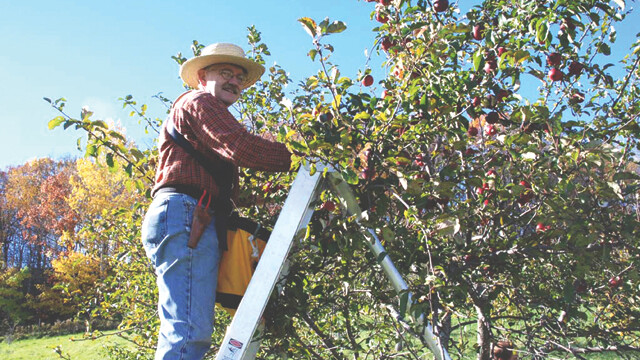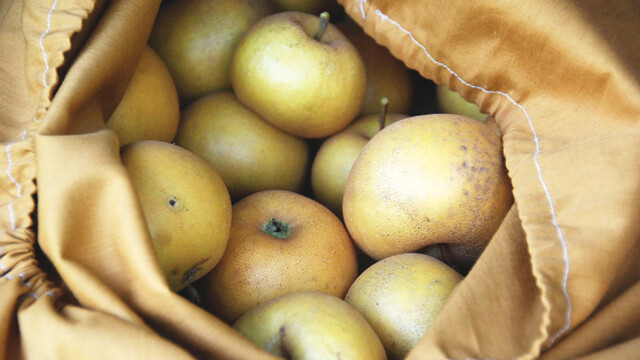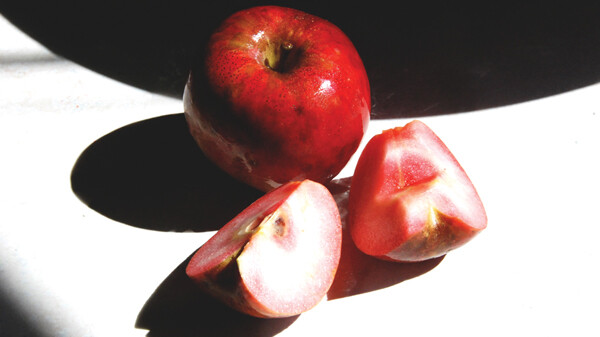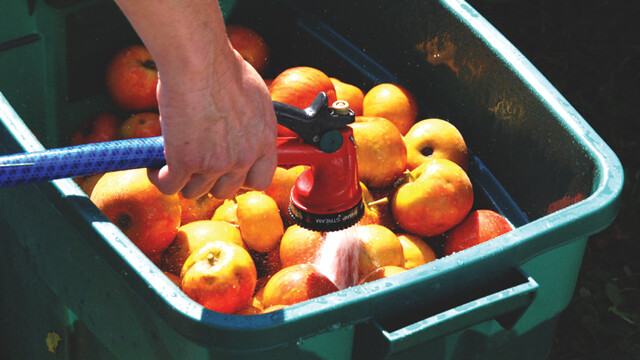How ’bout them apples?
after two decades of trial and error, hobbyist’s orchard is bearing fruit

My dad and I enjoyed growing evergreens when I was a boy, and as an adult I decided – I’m not sure why – to focus on growing apples. In 1993 I grafted my first apple trees, and in 1994 I bought roughly two acres from a relative near Prairie Farm, Wis., about half an hour north of Menomonie. In 1995 I started my orchard and began my plantings and tending the trees. I never intending to be practical, spend much money, or make money with the orchard. Because I never got a good look at a real orchard, I proceeded to make a dizzying number of bone-headed mistakes. In spite of my frequently failures, I ultimately succeeded because apples are so forgiving. I have plenty of apples to play with now, and more than ever I am entranced by them. Now that I’ve become a self-proclaimed expert – or at least know more than I did – it’s a good time to share my lessons.
The Hardier, The Better
There is a great variation in hardiness of apple varieties and I figured that since I was planting so many types of apples, I could try the whole range of apples and accept the consequences. What I found was that the apples that did the best were the ones developed in the north, especially from the University of Minnesota breeding program. Unlike the tender varieties that died in droves or lingered on painfully, hardy types grow faster, mature well, and more consistently give bigger, tastier fruit.
Because I have limited space and energy, I chose to do what is called top working. I would establish a hardy tree and, a ways up into the tree, graft another variety on a side branch. I have had good luck grafting more tender varieties on hardy trees, although I still have had losses. This has given me a chance to try more apple varieties. Grafting just one additional variety on a tree seems to work the best for me. I’ve tried grafting up to five extra varieties on a tree but this results in circus-like specimens. The poor things are confused, less healthy, and more likely to die.
Grow Your Own

I have chosen to try many types of apples that I’ve read up on: for fresh eating, for cooking, for cider, for jellies, for earliness, and for red flesh. My wife has insisted that if I drag big bags of fruit home with me, I must help do things with them. I dry many large jars of apples; that’s my specialty. We make a substantial amount of applesauce. We’re still looking for the perfect apple crisp apple. We’ve made jelly and apple butter. With a wide number of apple types, I ultimately should be able to find just the right apple for every cooking occasion. Apples must be used quickly in our household; we don’t have much refrigerator space and even the long keepers don’t keep well at room temperature. I don’t have a root cellar, which would help.
"You may wonder whether I regret overdoing it. The answer is that apples have become like my children, more interesting as I’ve gotten to know them as adults."
People ask me what varieties of apples to plant. You need to ask yourself what you are going to do with the apples. If it’s primarily for eating, I’d recommend Zestar, because it’s unusually good for an early variety; Honeycrisp, because it’s later and outstanding; and Keepsake because it is a good late apple and a notable long keeper. For cooking, Haralson is still hard to beat because it keeps its shape and has a marvelous flavor when cooked. These are for sensible people.
If you are not bound by practicality or the ordinary, you could try some of these:
1. St. Edmund’s Russet: This is a very old apple with russeting – somewhat fuzzy suede-like brown skin – that has a uniquely pleasant pear-like flavor. It was the winner of a recent impromptu group apple tasting at my orchard.
2. Chestnut Crab: This is a hardy Minnesota apple and my wife’s favorite for eating out of hand. She claims it’s like eating candy. In a good year it has everything – taste, aroma, crispness, sweetness, looks, and a tannin bite – except for its small size. This is our favorite in a class of good-eating crab apples.
3. Winekist and Almata: These varieties are quite similar with good-sized red-fleshed apples and make great dark-pink applesauce. Their skin is really red. Their leaves and wood are even red. Their flaw is that their fruit keeps only a few days.
4. Kandil Sinap: This oddly shaped small apple has delicious fruit on a small tree. It is from Turkey or nearby Southern Russia. It has been hardy for me, which is surprising.
5. Roland Baker: My cousin Roland Baker gave me a root cutting from the original tree that was found near Centuria, Wis. I’m naming it after him (and his father of the same name). Although it isn’t a commercially tested tree, it has all sorts of good qualities including hardiness, splendid health, nice branch structure, and large flawless good tasting fruit. The family connection is a bonus.
6. Cortland: This is a well-know moderately old variety with a good reputation it deserves.
7. Minnesota 1734: This one was developed by the University of Minnesota but never given a name. It has been referred to as the Minnesota Russet. It is one of my oldest trees – grafted in 1993 – and the biggest, best-shaped, most-productive. and healthiest tree in my collection. I haven’t figured out cider making – which is an art – but it has quite the reputation as a cider apple.
8. McIntosh: I recently added this fellow, one of the great apples with many offspring, after tasting a specimen from my relative’s farm. It had ripened to perfection. I believe it was the best fresh apple I’ve ever tasted.
For those intriguing individuals in my collection that are not fully hardy, the adventuresome local grafter should consider:
1. King David: In a good year, this apple has an eye-popping flavor that I really like. These have a take-no-prisoners taste the best apple should have, in my opinion. They mature late but are worth the wait.
2. Ashmead’s Kernel: This one has an amazing reputation as a high-flavored English apple, and it deserves it. It is russeted and doesn’t look like much, but oh the taste!
3. Briggs Auburn: Every apple varies in taste from year to year. Several years ago this unusual East Coast heirloom was wonderful. I can’t wait for another good year.
4. Jonagold: This is a relatively new apple but has many good qualities, including its large size and outstanding taste.
Critters, Weeds, and Weather

My orchard on a side hill facing east with some protection by woods uphill to the west. It has rich, heavy soil – an old barnyard – and the weeds grow amazingly well. I decided to plant standard-sized trees since they are hardier, I don’t live near the orchard to coddle them, and they stand up better to the large local deer herd.
The lesson of my first years was that small apple trees are amazingly vulnerable and almost everything eats them, including mice, gophers, rabbits, deer, and cattle. My biggest apple enemies still are the smallest, the mice, which will girdle even 20-foot trees if given a chance. I tried various schemes but now think that hardware cloth enclosures work the best to keep rodents out. I use higher fencing for deer. Once trees reach 7 feet or so, they are less vulnerable to deer, but rodents remain a problem.
Fortunately, I have had little trouble with insect damage at my orchard. In the yard of my White Bear Lake, Minn., home, however, I have a highly disease- and bug-resistant apple that consistently has insect damage. I attribute the difference to the relatively sterile environment in my suburban yard. At my Wisconsin orchard, there is a full range of animal and insect life. I have a little brook, grassy areas, and woods on my land that all are filled with life. I don’t have a certified organic orchard but have never sprayed, haven’t used any chemicals in recent times, and had good results. Maybe this is more than dumb luck. I’d suggest trying apples without chemicals and seeing what happens.
Controlling weeds has been a fundamental headache and long-term failure of mine; I lost trees outright and years of tree growth because I failed to deal with this. Only this year did I finally get the means to control vegetation around my apple trees: a large zero-turn mower. Fruit trees’ roots are primarily near the surface and must compete with other plants for nutrients. Competing vegetation can end up head-high by mid-summer when not cut. I removed weeds by hand around trees – backbreaking labor – and used a large mower behind a tractor a few times a year for the rest of the orchard. The weeds always seemed to win. I belatedly realized that grafted trees I gave to my relatives across the road did considerably better than ones I planted in the orchard the same year – their faithful mowing was the difference. Being thrifty is a virtue, but I should have bought a decent mower and subjugated my trees’ competition years ago.
Final Thoughts

I’ve had to revise this article since writing it last fall because the winter of 2013-14 was the most intensely cold one since the orchard was planted. It killed a sizeable fraction of my tender varieties, including King David and Jonagold. I’m going to regraft a number of the tender varieties that I like so I can taste and use them again. For others willing to take their chances with non-native varieties, I’d suggest grafting on side branches midway up into the tree and not putting multiple grafts on the same tree. Keep in mind that mid-winter cold snaps aren’t the only dangers. I have discovered that late frosts, particularly in those years when we had an early warm-up, damage and even kill tender varieties, too.
I could continue pontificating about my apples, but you’ve had enough. As you can tell, this hobby has gotten out of hand. As of last fall, I had 77 apple trees with 112 varieties represented (although after the winter there are a few less trees and many fewer varieties). I also have a number of pear and plum tree – I’m no purist.
You may wonder whether I regret overdoing it. The answer is that apples have become like my children, more interesting as I’ve gotten to know them as adults. They are one of the best flowering trees in the spring, reasonably easy to grow, productive, nutritious, varied in their uses, the heart of many recipes, reasonably resistant to disease, embedded in the country traditions of America, and beautiful. Although I wouldn’t suggest going bonkers over them as I have, they are well worth having in your yard. They are truly a noble fruit, generous and friendly, a fine addition to any family.
Leighton grows apples at his orchard in Dunn County, gardens at his home in the Twin Cities, and take photographs everywhere.






















